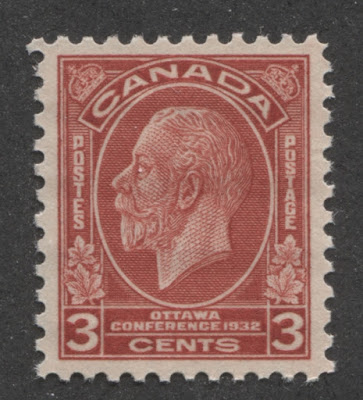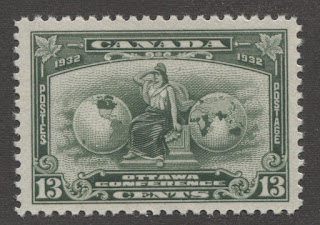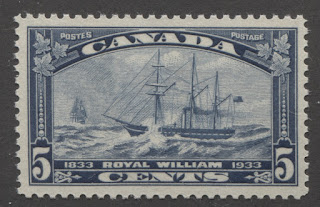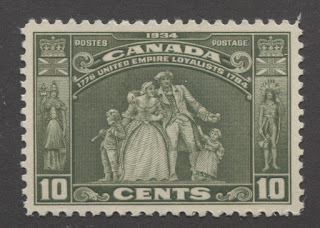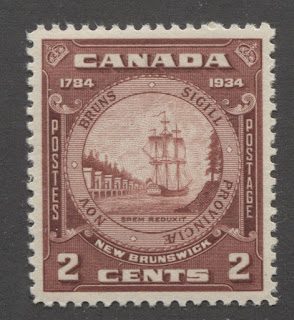Today's post comes a few days later than scheduled, and will be my last post until October 10. However it deals with a very fruitful and neglected group of stamps: the commemorative issues of 1932-34. This group of stamps were all printed by the British American Bank Note Company using the flat plate method of printing, except for the 3c Ottawa Conference, which was printed using rotary presses. The print quantities were relatively small compared to both the definitive issues at the time as well as later commemorative issues. There are very few collectible shade varieties. However, there are some good paper and gum varieties, imperforates, proof material, plate flaws, plate blocks, first day covers, postal history and of course, because of their size, lots of opportunity to collect cancellations. Centering tends to be poor for these issues, so finding very well centered stamps is a worthy challenge, particularly for the plate blocks. The perforations tended to be 11, which is a very coarse gauge, so stamps with full and even perforations on all four sides are quite difficult to find, especially if they are very well centered and never hinged.
All in all, as the next two posts will demonstrate, this little group of ten stamps can provide the basis for a fantastic specialized collection.
The Stamp Designs, Issue Dates and Quantities



 This variety appears as a heavy vertical dash on the face of the sailor in the foreground immediately below Jacques Cartier. It came from position 97 of the right pane of plate 2. Again, it is usually collected in block of 4.
This variety appears as a heavy vertical dash on the face of the sailor in the foreground immediately below Jacques Cartier. It came from position 97 of the right pane of plate 2. Again, it is usually collected in block of 4.
The Hairline From Hand Variety

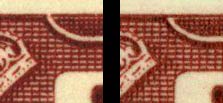
All in all, as the next two posts will demonstrate, this little group of ten stamps can provide the basis for a fantastic specialized collection.
The Stamp Designs, Issue Dates and Quantities
3c deep scarlet King George V
Issued July 12, 1932
100,700,000 stamps
5c steel blue Prince of Wales
Issued July 12, 1932
8,300,000 stamps
6c on 5c olive sepia
Issued July 12, 1932
500,000 stamps
13c deep green Britannia
Issued July 12
2,000,000 stamps
5c deep steel blue Parliament Buildings
Issued May 18, 1933
5,100,000 stamps
20c deep Indian red harvesting wheat
Issued July 24, 1933
1,580,000 stamps
5c deep steel blue Royal William
Issued August 17, 1933
4,854,000 stamps
Engraved by Bruce Hay
Based on a painting by Stephan D. Skillet
3c deep steel blue Jacques Cartier
Issued July 1, 1934
12,370,000 stamps
Designed by George Arthur Gundersen
Engraved by Bruce Hay
10c olive green Loyalists statue
Issued July 1, 1934
3,000,000 stamps
Designed by Robert Bruce McCracken
Based on a sculpture by Sydney March
2c deep lake brown New Brunswick Seal
Issued August 16, 1934
5,050,000 stamps
Points of Interest
There are many, many directions in which a collection of these stamps can be taken including:
1. Shade varieties
2. Paper and gum varieties
3. Plate blocks
4. Imperforate pairs and blocks
5. Plate flaws
6. Proof material
7. OHMS perfins
8. Postal history
9. First day covers
10. Cancellations
Today's post will address the first five of these aspects, while my next post will address the other five.
Shade Varieties
These issues display a remarkable uniformity of colour in the printing, probably due to the relatively small print runs and the fact that most were probably produced in one single printing. However, if you look hard enough, you can find some shade varieties, particularly the 20c Grain Exhibition and the 2c New Brunswick Issues. Some of the shade varieties on these include:
Regina Grain Exhibition Issue
- Brownish vermilion
- Deep Indian red
- Indian red
- Deep brownish vermilion
- Deep orange brown red
- Very deep brownish orange vermilion
- Deep brown red
Founding of New Brunswick Issue
- Deep lake brown
- Deep bright red brown
- Bright red brown
- Deep brown red
Even the other issues do exhibit some shade variation:
- On the 10c Loyalists issue the predominant shade is olive green, but greyish olive and deep greyish olive are also seen. The variation is very subtle, but can be seen up close, or by comparison with larger blocks in the different shades.
- The 3c Cartier Issue varies from steel blue to deep steel blue.
Other shades may exist, though I think the above list likely covers them all.
Paper and Gum Varieties
Most of these issues had very short periods of use, and consequently they are generally found with only one combination of paper and gum type. My second last post discusses these in detail, so I am not going to repeat the details here, but you can read about them by clicking on this link:
Notably the 20c Regina Grain Exhibition and the 6c on 5c Ottawa conference were produced from stocks of definitives, so they do exhibit more variation in both paper and gum than the other issues do.
Plate Blocks
Due to the limited number of stamps printed there were rarely more than 1 or 2 plates used to print the stamps. Many issues only had inscriptions on 2 or 3 corners as well, so for some issues, it is not possible to obtain 4 corner blocks with inscriptions. All the plate blocks are valued quite a bit higher than the corresponding catalogue value of the stamps though, especially in VF condition. For example:
- The 5c Ottawa conference catalogues between 2-2.5 times the price of four single stamps, depending on condition.
- The 13c Ottawa conference catalogues between 2.15 and 2.5 times the price of four single stamps, depending on condition.
Thus, although the number of collectible plate blocks for these is limited, the difficulty of finding well centered blocks, the catalogue prices and the NH premium of 100%, makes this an expensive endeavour. The plate blocks that can be collected include:
- 3c Ottawa Conference: plates 1 and 2 - 4 positions each for a total of 8 blocks.
- 5c Ottawa Conference: plate 1 - 4 positions, 4 blocks.
- 13c Ottawa Conference: plates 1&2, 2 positions each, 4 blocks.
- 5c UPU Conference: plates 1&2, 4 positions each, 6 blocks.
- 20c Regina Grain Exhibition: plate 1 only, 4 positions, 4 blocks.
- 5c Royal William Issue: plates 1&2, 4 positions each, 6 blocks.
- 3c Jacques Cartier Issue: plates 1&2, 4 positions each, 8 blocks.
- 10c Loyalists Issue: Plate 1, 4 positions, 4 blocks.
- 2c New Brunswick Issue: plates 1&2, 4 positions each, 6 blocks.
In the case of the UPU Conference, Royal William and New Brunswick Issues the imprints are only found on the upper positions. The lower corner blocks are always blank.
So even with this limited number of stamps, a complete set of plate blocks comprises 50 blocks is worth several thousand dollars.
Imperforate Pairs and Blocks
The imperforate pairs and plate blocks comprise some of the rarest and most valuable material from these issues. With fewer than 100 known pairs of every variety, these pairs are very rare and seldom offered for sale. You could easily spend a decade looking for them all:
- 5c UPU Issue (75 pairs, 4 plate blocks)
- 20c Regina Grain Exhibition (75 pairs, 3 plate blocks)
- 5c Royal William (75 pairs, 4 plate blocks)
- 3c Jacques Cartier (125 pairs, 5 plate blocks)
- 10c Loyalists (75 pairs, 2 plate blocks)
- 2c New Brunswick (80 pairs, 35 with closed frameline, 2 plate blocks)
The pairs generally list for between $800-$3,500 in Unitrade, depending on whether or not they are hinged, while the plate blocks are worth from $2,000 to $6,000 each.
Plate Flaws
These issues feature some of the best known constant plate flaws known to Canadian philatelists:
The Broken E Variety

The Broken E on the 3c Ottawa Conference. It is the "E" of "Postage" on the right stamp. It occurred on position 87 of the lower right pane from plate 2. It is often collected either in a block of 4, or a lower right block of 8.
The Line in 5 Variety
This variety occurs on the 1933 UPU Conference Issue. It consists of a small horizontal line extending across the lower part of the vertical branch of the right "5". Unfortunately I do not have an example of it that I can scan, and I do not have a picture of it online. However, it should be fairly self-explanatory. It occurs on position 20 of the sheet. I do not believe that it is truly constant, as it would appear that there are some upper right blocks from plate 1 which do not show the variety. However, it is not currently known on plate 2 blocks, which does suggest that it may have been limited to plate 1 only.
The broken X Variety

This variety consists of the upper right arm of the X being shorter than it should be. The variety is on the upper left stamp in the block. The variety occurs on position 19 of the sheet. Again, it is often collected as a block of 4, or in an upper right vertical block of 8.
The Burr Over The Shoulder Variety
The next three varieties all occur on the 3c Jacques Cartier issue. The most famous of these is the "burr over the shoulder" which is illustrated above. These are surprisingly scarce. This variety occurs on position 2 from the right pane of plate 2. Again, it is usually collected in blocks, but can also be found in wide gutter strips or gutter blocks.
The Scarface Variety
The Hairline From Hand Variety

Of all the varieties on this stamp, this one is probably the easiest to overlook because the line protruding from Cartier's hand is so fine. It occurs on position 89 from the right pane of plate 1.
The closed Frameline Variety

This variety occurs on all the stamps from the far right hand column of all sheets. The thing to look at is where the U-shaped frame at the top meets the upper frameline. On the left stamp we can see if we look closely that there is a very small gap in the upper frameline where the left part of the U-shaped frame joins the upper frameline, whereas no such gap is seen on the other side where it joins the upper frameline. However, if we look at the stamp on the right, we can see that the upper frameline is continuous, with no gaps. This is known as the closed frameline variety.
There may be other constant and non-constant varieties waiting to be discovered on these issues, though most can still be found in full sheets, though such sheets are now by no means common.


